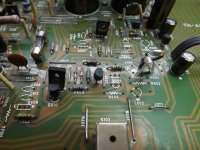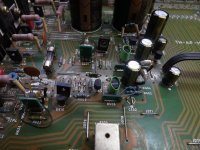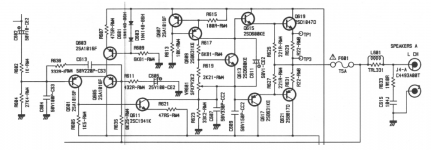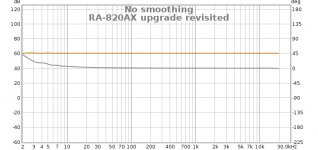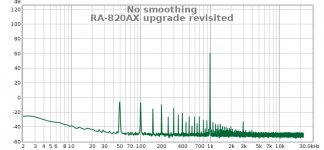long story short: if the dc current can act on the mm cart it will lower the frequency so you don't need a high pass output filter, if it can't do anything to the mm cart then you don't need a fet op-amp for this matter, rather for noise perpectives...but that again is just another matter that has been discussed here a lot as it can be measured, but can't be heard...
The current bias through the magnetic core of a catridge will do what any dc bias does ...lower the ability to respond at the lowest frequencies
Sorry, that is simply not so. I have designed micro sensors where we applied a dc bias to move the anchor to the exact right contact pressure onto a rabbit's gall bladder. I could - through some clever filtering - easily measure very low frequency pressure variations through the coil movements.
As for complete dc response at power on and power off amp's output state becomes critical for the speakers health...
Capacitor coupling won't change the on/off thumps, they will still go right through to the speakers. There is still a 4u7 dc block at the preamp input to sort out any standing dc - or do you suggest to go back to putting a large electrolytic on the output of the amp?
Per
i think you're quoting only what you want...Out of my last three posts you chose to quote only the version you like to fight...By the way...12 years ago i used to calibrate 5 decimals Mettler Toledo weighing scales.Do whatever you want with your Rotels...i'm not really interested.What some people hear as celestial sounds others can't hear at all...Every single time you modify an audio equipment it will sound different, but that is all about it.A simple recap for the electrolitics first can do wonders, but few moders usually listen to the original amp after recapping, before making any modifications.They simply assume that what they are doing must be better than the manufacturer's job.There are countless better op-amps than opa2134 for that matter.By the way...Panasonic FM is a very low esr cap...quite useless in your megogm circuit and while you noted that the input current may harm the cartridge, it can actually contribute more as noise through the feedback network than anything else. The true sound of that preamp is given by those styroflex capacitors and one op-amp voltage feedback topologies were never great enough.AD743/45 are trully low noise and offset for that application, but the most limitting factor in the voltage feedback op-amp based phono preamp is the power supply correlated with the transients due to dust and the common mode distortions aren't great in ne5532,nor in opa2134. Try opa2132 instead for that matter.The lme49710 passive network app is smarter than most people think because a passive network plus the huge input current noise gets you more noise apparently, but it wipes out the noisy transients and its noise is bellow the vinyl surface anyway.
Last edited:
in your circuit i'd try m5220 first, and old production lm833 before any other modern op-amps.
Last edited:
RA-820AX upgrades revisited
I am just trying to describe how I do things - not to claim myself better or worse than anyone else, but by actually doing and documenting the upgrades - so I think I'll just crack on:
Stage 3: Power amp
There have been quite a few changes in my power stage upgrade approach since the first posts on this thread 4-5 years ago. I have given up on cascoding, etc. - it worked beautifully, but it always led to a melange of bent transistor legs and airwires. I also now have abandoned the rail filters as I found that if you put in a concerted effort to get the input stage precisely balanced, the Power Supply Rejection Ratio (PSRR) increases sharply (which I should have known - as when I worked with sensitive medical circuits I saw first hand what mis-loading a precision opamp does to the PSRR – it drops like a stone!).
This also does away with the need for cutting pcb tracks, drilling holes and scraping open solder pads etc. which appeals to me (yes, I am indeed a lazy plonker) but also increases the overall reliability of the upgrade.
So, key is: a) precisely matched input LTP transistors, b) balancing their base resistor loads, c) a good current mirror, d) a more advanced VAS stage and e) removing Rotel’s heavy VAS loading.
Thus I will be removing 13 components in each channel – for Lch: C601/605/607/609/611/613, R601/603/605/623, Q601/603/607. You can choose to do each replacement one at a time, but I normally remove all 26 at once to get better access to clean up the pcb. See pic.
And so, here we go:
C601/02 – replace with a wire short. (Direct couples the stage to the preamp).
C605/06 - repace with 220[FONT=FreeSans, sans-serif]µ[/FONT]F FM. (Improves the low SPL and phase linearity).
C607/08 - replace with 27pF PS. (Low value cap for extra HF stability).
C609/10 – leave open. (VAS load reduction).
C611/12 - replace with 68pF PS. (Second Miller feedback capacitor).
C613/14 – replace with 1[FONT=FreeSans, sans-serif]µ[/FONT]F film. (Helps output stage de-charge at crossover).
R601/02 - replace with 681R MF
R603/04 - replace with 19k6 MF (Maintains stage gain while matching both LTP input transistor base loading to 8k2).
R623/24 – leave open. (VAS load reduction).
R605/06 - replace with the CM1 current mirror module, ensuring that the pin marked V- goes into the negative rail pcb hole. Blue wire is connected to one of the collector pins of:
Q601/03 Q02/04 – replace with matched KSA992 pairs.(Greatly improves input balance).
Ensure that the KSA992 with the lifted pin and blue wire goes in the Q603/04 pcb places.
Q607/08 – replace with the VAS3 module. Ensure that the pin marked ”E” goes in the corresponding ”E” hole in the pcb. Connect the black lead to the ground pcb hole left by the removed R623/24. (VAS3 contains more upgrade magic fairy dust, more detail later).
(Getting the modules’ orientation right is not difficult – in the RA-820AX all are facing towards the back of the amp.)
That’s basically all.
Nothing to it.
Measurements and listening test to follow. Stay tuned.
Per
I am just trying to describe how I do things - not to claim myself better or worse than anyone else, but by actually doing and documenting the upgrades - so I think I'll just crack on:

Stage 3: Power amp
There have been quite a few changes in my power stage upgrade approach since the first posts on this thread 4-5 years ago. I have given up on cascoding, etc. - it worked beautifully, but it always led to a melange of bent transistor legs and airwires. I also now have abandoned the rail filters as I found that if you put in a concerted effort to get the input stage precisely balanced, the Power Supply Rejection Ratio (PSRR) increases sharply (which I should have known - as when I worked with sensitive medical circuits I saw first hand what mis-loading a precision opamp does to the PSRR – it drops like a stone!).
This also does away with the need for cutting pcb tracks, drilling holes and scraping open solder pads etc. which appeals to me (yes, I am indeed a lazy plonker) but also increases the overall reliability of the upgrade.
So, key is: a) precisely matched input LTP transistors, b) balancing their base resistor loads, c) a good current mirror, d) a more advanced VAS stage and e) removing Rotel’s heavy VAS loading.
Thus I will be removing 13 components in each channel – for Lch: C601/605/607/609/611/613, R601/603/605/623, Q601/603/607. You can choose to do each replacement one at a time, but I normally remove all 26 at once to get better access to clean up the pcb. See pic.
And so, here we go:
C601/02 – replace with a wire short. (Direct couples the stage to the preamp).
C605/06 - repace with 220[FONT=FreeSans, sans-serif]µ[/FONT]F FM. (Improves the low SPL and phase linearity).
C607/08 - replace with 27pF PS. (Low value cap for extra HF stability).
C609/10 – leave open. (VAS load reduction).
C611/12 - replace with 68pF PS. (Second Miller feedback capacitor).
C613/14 – replace with 1[FONT=FreeSans, sans-serif]µ[/FONT]F film. (Helps output stage de-charge at crossover).
R601/02 - replace with 681R MF
R603/04 - replace with 19k6 MF (Maintains stage gain while matching both LTP input transistor base loading to 8k2).
R623/24 – leave open. (VAS load reduction).
R605/06 - replace with the CM1 current mirror module, ensuring that the pin marked V- goes into the negative rail pcb hole. Blue wire is connected to one of the collector pins of:
Q601/03 Q02/04 – replace with matched KSA992 pairs.(Greatly improves input balance).
Ensure that the KSA992 with the lifted pin and blue wire goes in the Q603/04 pcb places.
Q607/08 – replace with the VAS3 module. Ensure that the pin marked ”E” goes in the corresponding ”E” hole in the pcb. Connect the black lead to the ground pcb hole left by the removed R623/24. (VAS3 contains more upgrade magic fairy dust, more detail later).
(Getting the modules’ orientation right is not difficult – in the RA-820AX all are facing towards the back of the amp.)
That’s basically all.

Nothing to it.

Measurements and listening test to follow. Stay tuned.
Per
Attachments
Last edited:
r601...604 change is supplimentary loading the tone stack changing its curves...
I'm also not convinced what removing r623 and lowering its paralleled capacitor value and c609 removal would do to the amp's stability either.They're not just loading the vas...As long as you chose to not add any cascode the main amp response surely needs compensation.Besides the original 2sa1016 are better transistors than ksa992 ...
I'm also not convinced what removing r623 and lowering its paralleled capacitor value and c609 removal would do to the amp's stability either.They're not just loading the vas...As long as you chose to not add any cascode the main amp response surely needs compensation.Besides the original 2sa1016 are better transistors than ksa992 ...
Per,
Once you have finished your go-thru of the 820AX, it would be appreciated if you could find the time to share some thoughts on the RB-976 6-channel amplifier.
I have had one in "storage" for years and I'm considering implementing some of your modifications.
as far as I can see, the power stages of RA-820AX and the RB-976 are quite similar in topology, but with some differences on RC-network snubbing the differential input, capacitor across bias network and output inductor/Zobel network.
Thanks
Lars
Once you have finished your go-thru of the 820AX, it would be appreciated if you could find the time to share some thoughts on the RB-976 6-channel amplifier.
I have had one in "storage" for years and I'm considering implementing some of your modifications.
as far as I can see, the power stages of RA-820AX and the RB-976 are quite similar in topology, but with some differences on RC-network snubbing the differential input, capacitor across bias network and output inductor/Zobel network.
Thanks
Lars
Attachments
r601...604 change is supplimentary loading the tone stack changing its curves...
...
The only one I know that is worried about changing curves is my wife (but please don't tell her I said so).😉
With all due respect, if you could bring yourself to flick through the first technical posts on this thread you will find that we have indeed been through these issues - as far as I remember I actually re-designed the tone circuit to investigate if there was any improvement or cause for concern. Which in real life is a b**ger to do as you will almost have to take the entire blessed amp apart to get to the PCB.
Or, you could start you own thread - how about "How to improve an amp by 20dB by theoretical arguments" - that would work.
Per
Last edited:
Per,
Once you have finished your go-thru of the 820AX, it would be appreciated if you could find the time to share some thoughts on the RB-976 6-channel amplifier.
Lars
Hi Lars,
Yes, that power amp circuit schematic is exactly like the 820's (actually more like the 930 where Rotel started to put the input RC filter in (see post#363).
I'll just finish the RA-820AX stuff first.
Per
you remind me of a younger me...Or, you could start you own thread - how about "How to improve an amp by 20dB by theoretical arguments" - that would work.
Per
well...i bet those Rotel stupid engineers added a few components more and purposely increased the amp's noise so that you can prove yourself...
RA-820AX upgrades revisited
So, what do the measurements show now?
Output offsets are now: 0.4 mV / 0.8 mV.
Both biases steadied easily at 4.5 mV.
Supply ripple down to 18 / 22 mVac.
Linearity is now from 2Hz (-0db) (orange trace). Upper -3dB is at 160 kHz
Overall amp phase linear from 10Hz (+4[FONT=FreeSans, sans-serif]°) [/FONT]and up (grey trace)
1kHz THD now at 0.0027% (green trace)
I didn’t measure slew rate or damping factor, but in my experience they are better as well.
Pretty good outcome for three relatively simple upgrade stages, eh?
And as to the sound…. well, I am absolutely no good at audiophile journalistic gibberish, so instead I think that I’ll just quote some of other AngelP Signature upgrade amp owners:
[FONT=Helvetica, Arial, sans-serif]Hi,
[FONT=Helvetica, Arial, sans-serif]Thought I would send you a note to complement you on the Angelp signature Rotel.[/FONT]
[FONT=Helvetica, Arial, sans-serif]I have been an audiophile since the seventies and have had many high end amps and receivers but I was blown away with every aspect of its musicality and sound stage.[/FONT]
[FONT=Helvetica, Arial, sans-serif]You have created a masterpiece in audio electronics and I thank you.[/FONT][/FONT]
Hi Per, It's James, have received the Rotel ra 930 AngelP amplifier and am now listening to Melanie Martinez cry baby album and WOW what a massive jump in sonic performance from my technics amp. You have truly transformed what was once a fabulous amp into a splendiferously spectacular work of art.
[FONT=Helvetica, Arial, sans-serif]Hey Per,[/FONT]
[FONT=Helvetica, Arial, sans-serif]Wow, mate just wow really! pure genius buddy, my deck is being unhelpful in balance but I am running Tidal on FLAC, oh the joy! what a unit and credit to your insight and ears! THANKS SO MUCH....[/FONT]
[FONT=Helvetica, Arial, sans-serif]Billy[/FONT]
[FONT=Helvetica, Arial, sans-serif]Hi Per, I'm absolutely delighted with my purchase. What a remarkable piece of audio engineering. The amp sounds wonderful with my Rogers 149 speakers.[/FONT]
And many more like it.
Or you can of course just read Paulus' post #446.
Per
(Updated schematic and details on the modules to follow. Stay tuned.)
So, what do the measurements show now?
Output offsets are now: 0.4 mV / 0.8 mV.
Both biases steadied easily at 4.5 mV.
Supply ripple down to 18 / 22 mVac.
Linearity is now from 2Hz (-0db) (orange trace). Upper -3dB is at 160 kHz
Overall amp phase linear from 10Hz (+4[FONT=FreeSans, sans-serif]°) [/FONT]and up (grey trace)
1kHz THD now at 0.0027% (green trace)
I didn’t measure slew rate or damping factor, but in my experience they are better as well.
Pretty good outcome for three relatively simple upgrade stages, eh?
And as to the sound…. well, I am absolutely no good at audiophile journalistic gibberish, so instead I think that I’ll just quote some of other AngelP Signature upgrade amp owners:
[FONT=Helvetica, Arial, sans-serif]Hi,
[FONT=Helvetica, Arial, sans-serif]Thought I would send you a note to complement you on the Angelp signature Rotel.[/FONT]
[FONT=Helvetica, Arial, sans-serif]I have been an audiophile since the seventies and have had many high end amps and receivers but I was blown away with every aspect of its musicality and sound stage.[/FONT]
[FONT=Helvetica, Arial, sans-serif]You have created a masterpiece in audio electronics and I thank you.[/FONT][/FONT]
Hi Per, It's James, have received the Rotel ra 930 AngelP amplifier and am now listening to Melanie Martinez cry baby album and WOW what a massive jump in sonic performance from my technics amp. You have truly transformed what was once a fabulous amp into a splendiferously spectacular work of art.
[FONT=Helvetica, Arial, sans-serif]Hey Per,[/FONT]
[FONT=Helvetica, Arial, sans-serif]Wow, mate just wow really! pure genius buddy, my deck is being unhelpful in balance but I am running Tidal on FLAC, oh the joy! what a unit and credit to your insight and ears! THANKS SO MUCH....[/FONT]
[FONT=Helvetica, Arial, sans-serif]Billy[/FONT]
[FONT=Helvetica, Arial, sans-serif]Hi Per, I'm absolutely delighted with my purchase. What a remarkable piece of audio engineering. The amp sounds wonderful with my Rogers 149 speakers.[/FONT]
And many more like it.
Or you can of course just read Paulus' post #446.

Per
(Updated schematic and details on the modules to follow. Stay tuned.)
Attachments
stability graphs are done to 100mhz...but usually show something wrong in between 100kHz and 10megHz and that is why you have such agressive compensation done by Rotel.And usually a sharp decrease of distortions around 1khz is associated with high frequency instability while agressive compensation roll off the audio band over 20khz increasing distortions...You can try some simple simulations and see for yourself.I bet Rotel Engineers measured their amps too...
Last edited:
The main thematic here is improving an amp's THD by 20db .That's easily done on any amp by screwing its stability .It might not be obvious until something wrong happens...
you remind me of a younger me...
well...i bet those Rotel stupid engineers added a few components more and purposely increased the amp's noise so that you can prove yourself...
He he, mate. I so sincerely wish that I could remind myself of a younger me... Sorry, I didn't mean to be that cheeky.
But you just have to put more meat on your comments - explanations or measurements to back up the claims. I mean, things like "the original 2SA1016's are better than the KSA992" doesn't really help the many thread followers who want to understand why - and the wherefore that may be so.
The Rotels were designed by Stan Curtis in the UK and he maintained the heavy dominant pole shunt compensation throughout almost all Rotel designs. Quoting Self - who in turn quotes Peter Baxandall: "The technique is in all respects sub-optimal", which for Peter was strong language indeed".
But it gave the Rotels their distinctive, easy listening soft, rounded and 'pleasing' sound. And you can't argue with the impressive sales figures that this did indeed appeal to a lot of people.
Removing the 330pF||33k VAS load and replacing with a better VAS Miller 'collector to base' feedback capacitor design suddenly removes the 'pleasantry' veil and make all the stars come out in detail. Do the Miller compensation right and you can also readily get rid of the 150pF PNP driver load without any stability concerns.
I will post how I apply the Miller caps on the modules.
Per
Last edited:
What power level are your THD measurements taken?
I measured 0.008% THD on the worst measuring channel of my RB850 at 1KHz and 2.9V RMS into a 10R resitive load.
Regarding the Rotel sound, I don't hear it as "soft and rounded". IMO it is similar to the older Naim sound and characteristic of what people liked in the 80s. It is lean and fast with some graininess to the upper mids.
However most of this sound characteristic comes from the PS. I have had 3 different amps in my RB850 chassis (using the 850 power transformers): Mooly MOSFET amp, TGM8 and the original. They all sound remarkably similar. The Mooly amp sounds quite different to how it sounded in a different chassis using differnt mains transformers - sadly, not as good.
I have also got an RA840BX. Maybe I should do your mods to see what the effect is. Must admit I wouldn't want it to sound more forward on brighter though.
I measured 0.008% THD on the worst measuring channel of my RB850 at 1KHz and 2.9V RMS into a 10R resitive load.
Regarding the Rotel sound, I don't hear it as "soft and rounded". IMO it is similar to the older Naim sound and characteristic of what people liked in the 80s. It is lean and fast with some graininess to the upper mids.
However most of this sound characteristic comes from the PS. I have had 3 different amps in my RB850 chassis (using the 850 power transformers): Mooly MOSFET amp, TGM8 and the original. They all sound remarkably similar. The Mooly amp sounds quite different to how it sounded in a different chassis using differnt mains transformers - sadly, not as good.
I have also got an RA840BX. Maybe I should do your mods to see what the effect is. Must admit I wouldn't want it to sound more forward on brighter though.
ok...did you ran any simulations or made any measurements up to 10mhz?
Yes, I do that every time I look at offset stability - and why I keep the input LTP transistors in close thermal contact.
I suspect you mean 10 or 100 MHz. Well I have a transistor FM radio near my workbench and I can ensure you that the only HF noise transmission on the dial up to 100MHz is the Wonderful BBC Radio 2.
And before you ask me for 100GHz - I did try to put an egg on the heatsink and watched it all afternoon. I am afraid I made a mess of it - but I managed to save the egg yolk for my steak Tatare dinner.
It was oscillatingly good!

Per
What power level are your THD measurements taken?
I measured 0.008% THD on the worst measuring channel of my RB850 at 1KHz and 2.9V RMS into a 10R resitive load.
However most of this sound characteristic comes from the PS.
I have also got an RA840BX. Maybe I should do your mods to see what the effect is. Must admit I wouldn't want it to sound more forward on brighter though.
My gear isn't calibrated to provide absolute THD values, but if I ensure that I use the same starting point and level every time, it can measure the differences between the upgrade stages. Hence the name of this thread.
Re PS. This is why I normally replace the old E-core with a toroidal in the RA-820AX, and will definitely do so in alp1961's 820AX. Although the old Rotel tranny isn't half bad (well built with copper belly band, etc.) it is actually one of the components in the amp that runs hottest. And if you try to take the amp to its limit - as I did in one of the earliest posts - it will blow its internal thermal fuse and go to the Eternal milli-Henry Hunting Grounds.
If you do upgrade, I am afraid that you will indeed lose the 80'ies graininess and get an amp that is very precise, detailed and clear - it sort of disappears from the sound reproduction chain leaving just the music. The hand taped 840BX pcb layout and diagonal jumpers etc. does not make the upgrade easier, though.
Per
should i suspect that you also remove the metal enclosure of your amp ?I suspect you mean 10 or 100 MHz. Well I have a transistor FM radio near my workbench and I can ensure you that the only HF noise transmission on the dial up to 100MHz is the Wonderful BBC Radio 2.
Per
- Home
- Amplifiers
- Solid State
- Improve a Rotel amp THD by 20dB!
